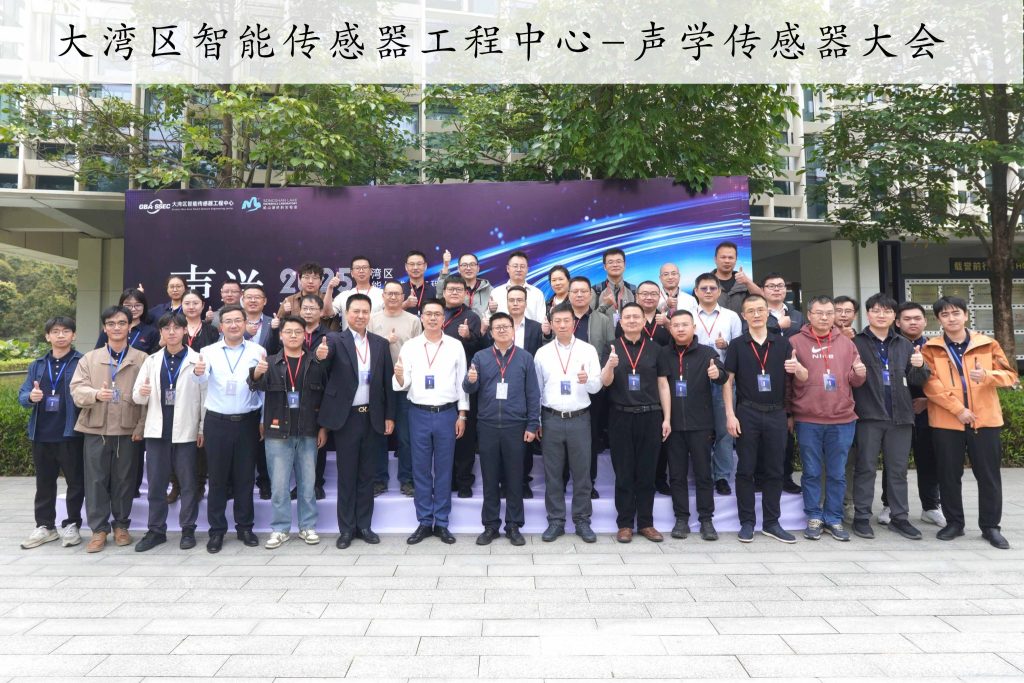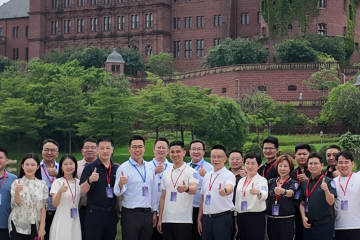On April 13, 2025, the "Acoustic Sensing - Smart Future: Technology Innovation and Industry Integration" Acoustic Sensors Exchange Seminar, co-sponsored by the Songshan Lake Materials Laboratory (SLSML) and the Greater Bay Area Intelligent Sensors Engineering Center (GBAISEC), was successfully held at the Conference Center of Dongguan Songshan Lake Materials Laboratory (DGLML). The meeting gathered top experts, scholars and enterprise representatives in the field of domestic acoustic sensing, focusing on the theme of "Acoustic Sensing New Paradigm, Industrial Wisdom Transformation", and explored the cutting-edge advances in acoustic sensing technology and the direction of industrialization through eight thematic reports and round-table dialogues, injecting new momentum into the high-quality development of the industry. This conference is co-organized by Sinocore (Dongguan) Science & Technology Co.

Frontier Report: Technological Breakthroughs and Scenario Innovations Drive Both Wheels
At the meeting, eight guests from academia and industry shared the latest research results and trend insights in the field of acoustic sensing.
With the title of "AI+sensor to build an intelligent sensor platform ecology", researcher Chao Zhang of Songshan Lake Materials Laboratory proposed a collaborative innovation model integrating artificial intelligence and sensing hardware, emphasizing the role of ecological platform in promoting the industry's cost reduction and efficiency as well as the importance of the engineer's culture and resource integration in the transformation of scientific and technological achievements into practical applications. The importance of sharing resources through diversified cooperation to form collaborative innovation in the sensor industry chain. With the title of "Acoustic Signal Processing in AGI Era", researcher Yan Yonghong from Institute of Acoustics, Chinese Academy of Sciences proposed a new paradigm of software reshaping the algorithms of acoustic sensors, explored the subversive innovation of traditional acoustic technology, systematically compared and analyzed the difference between acoustic theory mechanism-driven and data-driven in the training of the model, and shared typical cases in which the research driven by acoustic theory leads the innovation of the industry. driven research leading industry innovation in typical cases.

Figure 1: Rapporteur: Chao Zhang (left photo)| Figure 2: Rapporteur: Yonghong Yan (right photo)
Researcher Zhou Yu, Director of Acoustics Department of the Third Research Institute of CEC, systematically analyzed the strategic value of hydroacoustic transducer as a core device for ocean exploration in military, commercial and scientific research fields. He pointed out that the innovation of new composite materials, structure and process is expected to break through the limitation of low-frequency performance and expand its application prospect in the field of deep-sea exploration. Zhao Chenglong, Assistant General Manager of Suzhou Hedgecore Microelectronics, analyzed and summarized the independent and controllable silicon wheat MEMS process route and its challenges, as well as the innovative exploration and practice of platform-based capacitive sensors in solid-state microphones, electronic stethoscopes, and other emerging applications from the perspective of the MEMS microphone industry.

Figure 3: Rapporteur: Zhou Yu (left photo)| Figure 4: Rapporteur: Zhao Chenglong (right photo)
Prof. Yu Liang of Northwestern Polytechnical University analyzed in-depth the noise identification, monitoring and control methods for aviation machinery and equipment, proposed a series of innovative algorithms from the perspectives of frequency, randomness and sparsity, and shared specific application cases in combination with various application scenarios, such as aviation, industry and medical care. Yang Jie, Director of Industrial Acoustics Technology of National Intelligent Speech Innovation Center, introduced the center's progress in the research and development of industrial acoustic imaging technology and application areas such as power grid, machinery failure, noise identification, etc., focusing on passive acoustic imaging technology, i.e., receiving the target sound source signals through microphones and processing them with beam forming algorithms in order to realize the visualization of the distribution of the spatial sound sources.

Figure 5: Rapporteur: Yu Liang (left photo)| Figure 6: Rapporteur: Yang Jie (right photo)
Dr. Li Shiqi from University of Science and Technology Beijing introduced how dry-coupled acoustic wave testing technology can realize rock stress monitoring and accurate assessment of underground structural safety through non-contact detection, providing new tools for geological exploration and infrastructure safety. Mr. Dai Zhongyuan, Chief Product Officer of Beijing Lopid Technology, started from the consumer side of serving the needs of the elderly group, and proposed that "Big Model + Embodied Intelligence" will reconstruct the logic of human-machine voice interaction, and put forward a variety of practical application scenarios on the spot, showing the infinite possibilities of the fusion of acoustic technology and AI.

Figure 7: Reporter: Li Shiqi (left photo)| Figure 8: Reporter: Dai Zhongyuan (right photo)
Roundtable Dialogue: Blueprint for Acoustic Sensing in the Age of Embodied Intelligence
In the roundtable discussion of this acoustic technology symposium, eight guests from industry, academia and research centered on "acoustic perception and application in the era of embodied intelligence" to start an in-depth dialogue.
Representative enterprises in the Greater Bay Area, such as Tailor Technology and Vision Source, Sunrise Electronics, Jaho, and Able, as well as experts from the National Intelligent Speech Innovation Center, Northwestern Polytechnical University, and Nobid Technology, participated in the seminar, which was moderated by Mao Sining, Chief Scientist of Sinocore (Dongguan) Science and Technology Co.
The enterprise experts carried out a lively discussion around the scenarios of advanced vehicle-machine interaction, intelligentization of education scenarios, intelligent wearable, noise reduction and sound pickup for large-scale conferences, home-aged robots, motor diagnosis and other scenarios combined with the application of large models.

Contributing to the Greater Bay Area, Building a Highland for Acoustic Sensing Innovation
At the opening ceremony of the conference, Yan Xiaohui, Deputy Director of Dongguan Science and Technology Bureau, delivered a speech. He pointed out that as a nationally recognized manufacturing base, Dongguan is focusing on key areas such as high-end sensing chips, 5G RF chips and other key areas, and is committed to breaking through the core technology bottlenecks. Yan Xiaohui emphasized that the symposium organized by the Greater Bay Area Intelligent Sensor Engineering Center is an important initiative to implement the Guangdong, Hong Kong and Macao Greater Bay Area Intelligent Sensor Industry Development Plan, and it is also a practical exploration of the deep integration of the innovation chain of "basic research-technology research-industrial application".

In the future, the Engineering Center will focus on the sensor "acoustic, optical, electric, magnetic, force, thermal" multiple technical directions, the implementation of the "innovation chain - industry chain - ecological chain" three-chain fusion strategy, to carry out key technology research and transformation of results. To create a sensor + AI one-stop ecological service platform, to help the Greater Bay Area to build a 100 billion intelligent sensor industry cluster.
Call for Cooperation:

Thank you for your contribution to the advancement of smart sensing technology!

0 Comments